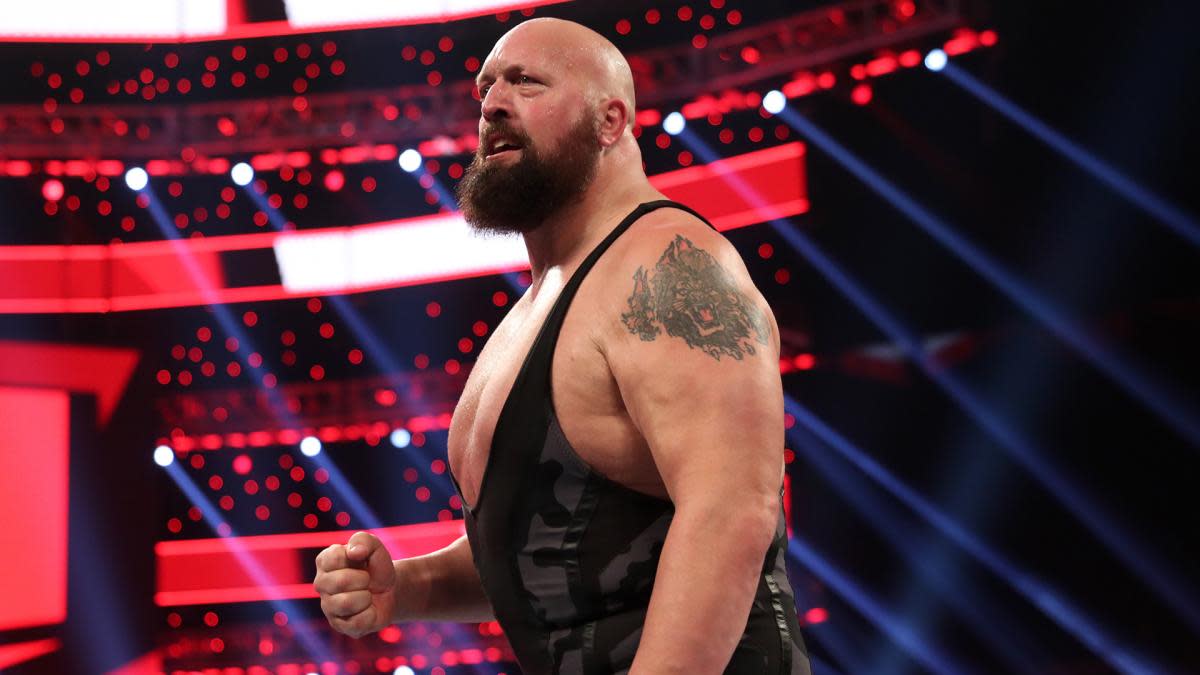Big Show Thankful for WWE Return After Five Surgeries to Fix Injured Hip


Paul Wight had one request for his return as the Big Show last week on Raw.
If it was truly going to be a surprise for him to return as Kevin Owens and Samoa Joe’s surprise partner against Seth Rollins and AOP, then Wight wanted it to be treated in that manner. Not even the other members of the roster could know he was in the building.
“That was old school,” said Wight, who has dedicated the past two-and-a-half decades of his life to the wrestling business. “Nowadays everybody knows everything, but our business is about suspending reality, bringing people along on a journey, and surprising them. For me, this was very cool to be a part of it.”
Wight’s reasoning makes complete sense, but it avoided the obvious question: how do you hide a giant?
The answer, of course, is carefully.
“They had me in an SUV with tainted windows, and I had a big Chrome Hearts hooded sweatshirt that I had over my head,” said Wight. “I tried to hunch over and hide. Once we got back to an area that no one could see, I walked into a private changing area.”
Wight then connected with Samoa Joe, who was in on the surprise, and prepared for his first match since November 2018. In those 15 months away from the ring, Wight battled though a long string of injuries in order to fulfill his goal of returning to the ring. The idea that he would be forced into retirement placed him in a depressed state.
“I have fought very hard for the past two years to get back in the ring and get back to a legit competitive state of mind and state of body,” said Wight. “My hip joint looked like a cracked bowling ball, and there were problems doing the surgery with someone of my size. I was depressed, my career was being taken away from me.
“I worked very hard through five different surgeries. I went through IV PICC lines for dealing with a surgical infection, to replacement joints, always believing I was going to get back to a point where I could compete. So last Monday, hearing an incredibly positive response from the crowd, I knew I was going to enjoy that moment.”
When the familiar sound of Big Show’s music hit last Monday, Wight was ready to embrace the moment.
“After two years of heartache and setbacks, that moment was everything to me,” said Wight. “I was very calm, I wanted to enjoy that moment. Now I need to keep earning my spot and make the most of every opportunity.”
Wight is only three years shy of turning 50 years old. He is acutely aware that his career as the Big Show is closer to the end than the beginning, but he is also confident that he still adds value to the current WWE product.
“I’m being counted on to contribute, and that’s exactly where I want to be,” said Wight. “This is a privilege. I’m 47, and there are a lot of younger guys who can do things I can’t do, so I have to prove the right to walk down that ramp. I’m doing this now because I love it, not because I have to.”
Wight is sharing the knowledge he has accumulated over the years, especially the lessons learned from The Undertaker—even if he did not initially appreciate the constant critiques.
“I used to come through the Gorilla position after a match against Undertaker on our live tours, and Undertaker would be there waiting for me,” recalled Wight. “He’d wave me over with that crooked finger, and he’d chew out my ass for the next 15 minutes. This happened night after night. It seemed like I couldn’t do anything right, no matter what I tried. And I’m a little more hard-headed than most, so it took me a while, but a lot of the lessons I learned from Undertaker put me in a position now where I can help a lot of people not make the same mistakes I made.”
Wight was already a star when he stormed into WWE in February 1999, having made his name as The Giant in WCW. But Wight explained that the standards of the two companies were very different, primarily due to the structure of the contracts.
“It was a lot different in WCW, which had guaranteed contracts,” said Wight. “WWE was a shark tank, it was competitive. It wasn’t a locker room where everyone went to Chipotle after the show together. People legitimately didn’t like each other.
“I was so young in WCW, I was 22, 23 years old at the beginning. The only other young guy was Alex Wright. Macho, Hulk, Flair, Paul Orndorff, they were all in their 40s or older. It was like I was everybody’s kid brother. And I made a lot of mistakes back then. My real training happened when I got to work with Undertaker.”
Wight is back in the ring this Monday, teaming with Owens and Joe once more against Rollins and AOP in a “fistfight” on Raw.
“I have no idea what to expect for this match,” said Wight. “I found out about it after we went off the air, after I thanked people and took selfies and signed some autographs. I came to the back for a dot-com interview, and that’s when I found out. I just started laughing when I heard it, because in my mind I’m thinking, ‘What is a fistfight match?’ What are we doing, taping our fists? Are all six of us fistfighting in the ring like a bar room brawl?
“I know AOP are two monsters and Seth Rollins can do anything, but other than that, I’m walking in blind so we’ll all find out together. It will probably be something where we’re asked to do the impossible in a short amount of time.”
Wrestling continues to evolve, especially compared to when Wight first broke into the business. In 1995, Wight’s athleticism for a big man, even compared to super heavyweights like Vader and Bam Bam Bigelow, was unparalleled. Wight has been a witness to many changes, both in the ring and throughout the business as a whole.
“The business isn’t quite as ruthless or individualistic as it used to be,” said Wight. “Now there’s a lot more of a team attitude in the dressing room. People are working hard together. We got it done back in the day, but that’s just because a lot of us were competitive and didn’t like each other. The work environment is a lot nicer now.
“And for me, for lack of a better term, I was banned for doing a lot of what I wanted to do. That’s because a lot of what I wanted to do didn’t make sense. I was supposed to be playing the role of a giant. I got cussed out for doing dropkicks off the top, I got cussed out for doing nip-ups in the ring. They didn’t want that from me, and that’s because the giant before was Andre, who had set a precedent [in his post-WrestleMania I run with WWE]. I wanted to bump and feed and be exciting. But one of the biggest advocates for me to be more creative in the ring is Vince.”
Wight has been wrestling so long that it feels as if his next move can be predicted before he makes it. This gives him all the more motivation to surprise people with the unexpected, like he did in his chain wrestling match with Braun Strowman in 2017.
“There are a few things that I want to slowly introduce,” said Wight. “We’re working into ’Mania, and I don’t know where I’m positioned for that, but there are a lot of things I want to get going. That depends on the opponent, the match set up, and whether it’s appropriate or not because it’s not about me, it’s about the creative theme Vince wants to do.”
Wight offered fascinating insight into what he is looking to accomplish, and how he plans to reach goals that will enhance the WWE product.
“I’ve had chain wrestling matches with Braun and another match like that with Kane, and I could have one hell of a chain wrestling match with Seth Rollins but it just wouldn’t make any damn sense,” said Wight. “The matches aren’t always about getting yourself over. That’s the biggest thing I tell young talent. They get in the mindset that, ‘I’ll do my stuff, you do your stuff, I’ll do my stuff.’ That’s not what a match is about. The first rule of thumb to have a long career is get the match over, get your opponent over, and if you do those two right, then getting yourself over will happen, too.
“Sometimes I can’t go out and get all my stuff in. We’re trying to build my opponent. I don’t need to be built, I don’t need title runs. I’m established, and I’m comfortable with my career and who I am. My goal is to enhance the people I’m in the ring with and help bring them to superstar level. That’s the part that is the joy now.”
Wight disputes the notion that wins and losses hold any significant value in pro wrestling.
“I’m not here to get wins,” said Wight. “Heck, I don’t know, I think I’ve won two matches in the past five years. It’s not about the win-loss record, it’s about the quality of work. No one has ever come up to me and said, ‘I can’t believe you lost that many times!’ People talk to me about what I’ve done, or cool moments like breaking the ring with Brock or Braun. They care about the moments, not about the win-loss record. And if I do it right, I’ll get myself over.”
The Big Show is back home on Raw, a place he has resided for the past 21 years. This run marks an opportunity to continue to share his knowledge, with the aim of elevating talent in the ring.
“I’m living a blessed life and I have zero complaints,” said Wight. “I’m doing what I love, working with some great people, and doing it on my terms. It can’t get any better than that—I’ve still got a lot to prove.”
Justin Barrasso can be reached at JBarrasso@gmail.com. Follow him on Twitter @JustinBarrasso.
